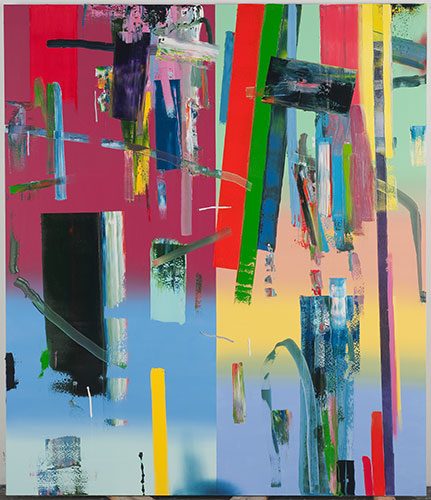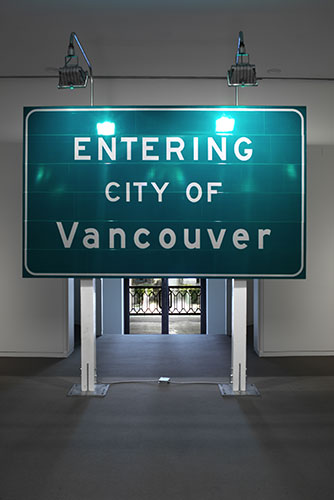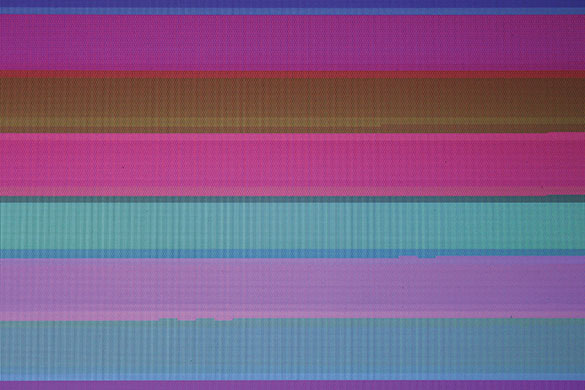Natasha Kerr's At the End of the Day, 2007, part of Quilts 1700-2010 at the V&A. Photograph: Richard Davis
The soldier looks peaceful but alarmingly pale. He has a metal plate lodged in his head. They've patched him up at the military hospital and even given him something to keep his mind off the horrors of the Crimea. He is sitting up in his nightshirt stitching the most startling quilt.
The triangles alternate black and white, black and red, red and yellow in fierce chevron stripes. It is a terrific piece of op-art geometry. The painting that commemorates Private Walker's labours shows not only the quilt and exactly how it is done, right down to the difficulty of keeping each fiddly little triangle from curling up as you stitch it to another, but something else too.
There on the bed lies Walker's uniform, complete with medal. The quilt turns out to be made of his regimental colours, almost literally – a piecing together of the torn clothes, if not the bodies, of the dead.
Are all quilts an act of commemoration, more or less public or private? It seems so from this tremendous exhibition. Quilts 1700-2010 has had more advance bookings than any other at the V&A, with visitors due to fly in from all round the world. It deserves its enormous success.
For what it shows is an art form that takes scraps of the real world and transforms them into visions and images, that shores up the fragments of the past while making something new (and warm) for the future. This is not quilting as commonly imagined – Laura Ashley pre-cut squares machined together for the guest room – but something infinitely more imaginative, idiosyncratic, personal; another way of drawing or painting, another form of narrative or expression.
Look at the unknown 18th-century woman who has stitched her entire world into a coverlet, beginning with the clock at the centre that measures time and life, radiating out through the day's objects – comb, thimble, scissors, the very needle she is using right now – to the emblems of her home and the garden beyond, where the spring birds arrive, then depart for the winter sun. It feels like the whole of an existence, circumscribed, confined and yet rich in the mind, condensed to the visual equivalent of a sonnet.
Look at James Williams's anthology of wonders – a camel, an elephant, a Chinese pagoda, the whale swallowing Jonah; to which he has proudly added a perfect cloth reprise of Thomas Telford's miraculous suspension bridge in Menai. Williams was a Welsh tailor. It took him a decade to piece the quilt together after work, and no wonder, for each vignette is united in a web of tiny shifting mosaics that feels like a dream adrift in the mind.
Ten years, 40 years: the curators have been able to determine from the fabrics themselves how long some of these quilts were under the needle – picked up and abandoned and picked up again. Each quilt is the measure of its own making. And as time passes, relationships and events are both implicit and explicit in the work. The death of a husband is felt in darkening tone and sombre embroidery; the length of a pregnancy apparent as the baby's name is eventually added after the relief of a safe birth. Quilts reflect family history as much as private lives.
Some of these histories turn out to be dark or sorrowful. Miss Nixon's quilt, made in the 1870s, and known as a strippy piece for its bold stripes of turkey-red and white cotton, was stitched in poverty at a miner's quilting club in Northumbria. The painstaking art is all in the patterning of diamonds, roses and leaves described with infinitely small stitches, perhaps compensating in this case for the lack of affordable cloth with which to vary the design.
Even an inexperienced eye can gauge how many long months of patience, skill and eyestrain were involved just by examining a single inch. But such quilts earned for Miss Nixon and her friends nothing more than the equivalent of a miner's wage for a fortnight.
Other quilts tell of lost children, unfaithful husbands, imprisonment and poverty, of persecuted Baptists and women convicts transported to Van Diemen's Land. One of the most dynamic – and vitality, not weakness, remains the dominant characteristic – is the so-called George III coverlet which shows the monarch reviewing his troops in the middle. But this formality is surrounded, and nearly upstaged, by a wonderful border in which official portraits of soldiers alternate with unofficial portraits of women: talking, writing, painting, laughing, walking and – of course – making quilts. There is no sense of Penelope sadly spinning away the war years; this is Homer revised, with women rising to the moment, refusing to waste either life or time.
This coverlet includes fragments of regency petticoat. The condition of life is materially apparent, so to speak, in a quilt. A tiny piece of expensive brocade, a circle of Indian fabric illegally imported during the 19th century trade ban, the lace from a Victorian wedding dress: what's prized is presented like a jewel in the ordinary cloth.
There are quilts made entirely from striped pyjamas, blankets, old coats, black-out curtains. Ingenuity is underpinned by frugality. The curators of this show had their ears to the ground when they first began to gather quilts five years ago, for this is an art that speaks more clearly than ever to our make-and-mend era.
And it does feel like speech. The most obvious (and commonly drawn) analogy is with abstract art: primary shapes, blocked colours, modular non-representational arrangements. Quilts have the shape and form of paintings; museums and collectors like to hang them on the walls. The great Amish quilts look like precursors to the minimalism of Sol Lewitt, Joseph Albers and Frank Stella.
But this is an exhibition of British quilts, and though there is one stunning abstraction, mute in its glowing cobalt and red, the sense is far more of representation, of the power of quilts to make a direct address.
Which is precisely the subject of a piece by Sara Impey, one of 10 works specially commissioned for this show. Impey found a letter in a drawer after her mother's death that breathed a hint of lost love; she has preserved it, like scented air in a bottle, in a most beautiful quilt in which phrases and half-phrases are stitched into the spectral surface of the fabric in broken lines that both imitate the patterns of speech and the motion of sewing itself, piercing the cloth, then drawing the thread slowly away.
We are all familiar with quilts that anthologise a family's old clothes, or commemorate its story through births or marriages; with quilts as complex pixellations of colour, tone and shape, patterned in jockey's cap or sawtooth star. But what this show reveals is the sheer originality that can thrive within such precise parameters. It is a show to enthral and inspire in equal measure, not least because there is such a sense of order in this hardwon art, this creation of a world out of scraps. It is all there in the portrait of Thomas Walker in his bed: the strange peace of making a quilt.






















